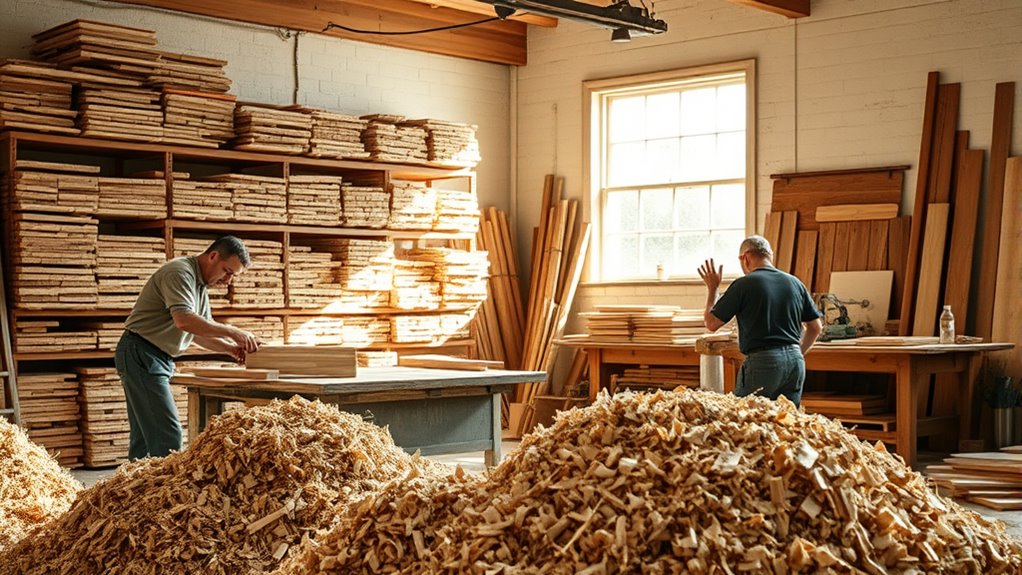Sustainable woodworking is a growing movement that emphasizes eco-friendly practices you can adopt, like using timber from responsibly managed forests and recycling leftover wood. You can also choose natural finishes and source materials locally to lower your carbon footprint. Efficient tools and waste management help reduce environmental impact and save costs. By embracing these practices, you support forest conservation, reduce waste, and create greener products—discover more ways to make your projects environmentally friendly.
Key Takeaways
- Emphasis on using timber from responsibly managed forests to support conservation and forest regeneration.
- Incorporation of reclaimed and recycled wood to minimize waste and promote resource reuse.
- Adoption of natural, biodegradable finishes and local sourcing to reduce environmental impact.
- Utilization of efficient design, digital tools, and energy-efficient machinery to optimize wood use and reduce waste.
- Growing consumer demand for eco-friendly products enhances market opportunities and promotes environmental stewardship.

Have you ever wondered how woodworking can be both beautiful and environmentally responsible? The answer lies in sustainable woodworking, a movement gaining momentum as artisans and hobbyists recognize the importance of protecting our planet while creating stunning pieces. This approach emphasizes using eco-friendly materials, such as wood from responsibly managed forests, ensuring that your projects don’t contribute to deforestation or biodiversity loss.
Sustainable woodworking combines beauty with eco-consciousness through responsible materials and mindful practices.
When you choose sustainably sourced timber, you’re supporting forest conservation efforts and helping maintain healthy ecosystems. Properly harvested wood ensures that forests can regenerate and continue providing vital ecological services, aligning with wood stove eco-friendly living principles of sustainable resource use.
Reducing waste is a core principle of sustainable woodworking. Instead of discarding leftover wood, you can recycle or reclaim it, giving old materials a new purpose and minimizing environmental impact. For example, reclaimed wood not only preserves resources but also adds character and history to your projects. Incorporating reclaimed wood into your work supports responsible material use and enhances the uniqueness of your creations.
Incorporating eco-friendly finishes, like natural oils and waxes, replaces toxic chemicals, making your work safer for both the environment and yourself. These finishes also enhance the natural beauty of wood without compromising sustainability. Additionally, choosing biodegradable finishes further reduces environmental impact and promotes a circular lifecycle for your projects.
Local sourcing plays a significant role in sustainable woodworking. By obtaining timber from nearby forests or suppliers, you cut down on carbon emissions linked to transportation. This practice supports local economies, creating jobs and fostering community growth.
Efficient resource management is another key aspect—using precise cutting techniques and digital design tools helps optimize wood usage, reducing waste and saving money over time. Furthermore, adopting energy-efficient machinery minimizes power consumption during your projects, further lowering your environmental footprint.
Tools and technology are advancing sustainable woodworking practices. Equipment designed for energy efficiency, along with specialized recycling machines, ensures waste is managed responsibly. You can also incorporate recycled materials into your designs, blending innovation with conservation.
These practices not only lessen environmental impact but also open up new creative possibilities.
The economic benefits of sustainable woodworking extend beyond environmental impact. Consumers increasingly favor products made with eco-conscious methods, boosting your reputation and fostering loyalty.
Reducing waste and improving efficiency can lead to cost savings, while the growing demand for eco-friendly goods offers new market opportunities. Supporting local suppliers and industries strengthens community ties and promotes long-term profitability, ensuring that resources remain available for future projects.
In essence, sustainable woodworking helps reduce carbon emissions by sourcing locally and practicing waste minimization. It preserves biodiversity by supporting responsible forest management, and it promotes a cycle of environmental stewardship.
Conclusion
By embracing sustainable woodworking, you subtly nurture a greener future, where every careful choice helps the environment thrive. Your dedication to using responsibly sourced materials and eco-friendly practices gently guides the industry toward more mindful ways of creating. As you continue this journey, you’ll find that small, thoughtful actions can quietly foster a more balanced relationship with nature—proving that even the gentlest efforts can lead to meaningful change. Keep nurturing this movement; it’s a quiet, powerful force.









